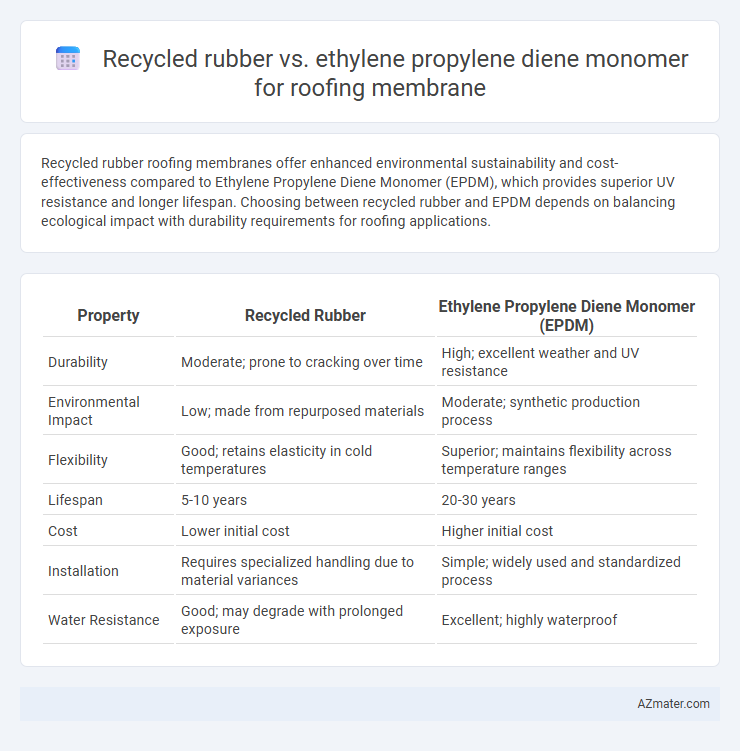Recycled rubber roofing membranes offer enhanced environmental sustainability and cost-effectiveness compared to Ethylene Propylene Diene Monomer (EPDM), which provides superior UV resistance and longer lifespan. Choosing between recycled rubber and EPDM depends on balancing ecological impact with durability requirements for roofing applications.
Table of Comparison
| Property | Recycled Rubber | Ethylene Propylene Diene Monomer (EPDM) |
|---|---|---|
| Durability | Moderate; prone to cracking over time | High; excellent weather and UV resistance |
| Environmental Impact | Low; made from repurposed materials | Moderate; synthetic production process |
| Flexibility | Good; retains elasticity in cold temperatures | Superior; maintains flexibility across temperature ranges |
| Lifespan | 5-10 years | 20-30 years |
| Cost | Lower initial cost | Higher initial cost |
| Installation | Requires specialized handling due to material variances | Simple; widely used and standardized process |
| Water Resistance | Good; may degrade with prolonged exposure | Excellent; highly waterproof |
Introduction to Sustainable Roofing Membranes
Recycled rubber and Ethylene Propylene Diene Monomer (EPDM) are prominent materials in sustainable roofing membranes due to their durability and environmental benefits. Recycled rubber roofing uses waste tires, reducing landfill impact and promoting circular economy practices, while EPDM offers excellent weather resistance and energy efficiency with a long service life. Both materials contribute to green building certifications by enhancing thermal insulation and minimizing environmental footprints in roofing applications.
Overview of Recycled Rubber Roofing Membranes
Recycled rubber roofing membranes, primarily made from reclaimed tires, offer exceptional durability and environmental benefits by reducing landfill waste and conserving resources. These membranes provide excellent elasticity, weather resistance, and UV stability, making them suitable for various roofing applications. Compared to Ethylene Propylene Diene Monomer (EPDM), recycled rubber membranes often present a cost-effective, sustainable alternative with similar performance characteristics and increased eco-friendliness.
Understanding Ethylene Propylene Diene Monomer (EPDM) Roofing
Ethylene Propylene Diene Monomer (EPDM) roofing membranes are highly durable synthetic rubber materials known for exceptional resistance to ultraviolet rays, ozone, and weathering, making them ideal for flat or low-slope roofs. Compared to recycled rubber roofing, EPDM offers superior elasticity, longer lifespan, and better thermal performance, reducing energy costs and maintenance needs. The single-ply EPDM membrane's seamless installation minimizes leaks, contributing to its enhanced waterproofing properties over recycled rubber counterparts.
Environmental Impact: Recycled Rubber vs EPDM
Recycled rubber roofing membranes significantly reduce landfill waste by repurposing used tires and industrial rubber, lowering the environmental footprint compared to virgin materials. Ethylene Propylene Diene Monomer (EPDM) membrane manufacturing involves petrochemical processes with higher greenhouse gas emissions and non-renewable resource consumption. Both materials offer durability, but recycled rubber promotes circular economy benefits, making it a more sustainable choice for eco-conscious roofing projects.
Durability and Lifespan Comparison
Recycled rubber roofing membranes offer good durability with resistance to weathering and moderate lifespan, typically lasting around 15 to 20 years depending on environmental conditions and installation quality. Ethylene propylene diene monomer (EPDM) membranes provide superior durability, exhibiting exceptional resistance to UV rays, ozone, and extreme temperatures, contributing to a longer lifespan often exceeding 30 years. EPDM's molecular structure enhances flexibility and tensile strength, reducing cracking and degradation over time compared to recycled rubber options.
Installation Processes and Ease
Recycled rubber roofing membranes offer flexibility and can be installed using heat welding or adhesive methods, making them adaptable to various roof shapes but sometimes requiring longer curing times. Ethylene propylene diene monomer (EPDM) membranes are typically attached using adhesives, mechanical fasteners, or ballasting, allowing for quicker installation and fewer seams due to larger panel sizes. EPDM's ease of handling and faster attachment processes generally result in reduced labor time compared to the often more labor-intensive installation of recycled rubber membranes.
Weather Resistance and Performance
Recycled rubber roofing membranes exhibit excellent weather resistance due to their inherent elasticity and UV stability, making them highly durable under extreme temperature fluctuations and exposure to sunlight. Ethylene propylene diene monomer (EPDM) roofing membranes offer superior ozone resistance and exceptional tensile strength, maintaining flexibility and performance over decades in harsh weather conditions. Both materials provide reliable waterproofing and resilience, but EPDM typically outperforms recycled rubber in sustained UV exposure and long-term weathering scenarios.
Cost Analysis: Initial Investment and Long-Term Value
Recycled rubber roofing membranes typically offer a lower initial investment compared to Ethylene Propylene Diene Monomer (EPDM) due to the use of repurposed materials, making them an economical choice for budget-conscious projects. EPDM membranes, while often more expensive upfront, provide superior durability, longer lifespan, and lower maintenance costs that enhance long-term value and reduce total cost of ownership. Cost analysis should weigh the immediate savings of recycled rubber against EPDM's extended performance benefits and life-cycle cost efficiency in roofing applications.
Maintenance Requirements and Considerations
Recycled rubber roofing membranes typically require routine inspections for cracks and degradation due to their susceptibility to UV damage, necessitating periodic cleaning and occasional recoating to maintain flexibility and waterproofing. Ethylene propylene diene monomer (EPDM) membranes offer superior durability with minimal maintenance, as their high resistance to ozone, UV rays, and temperature extremes reduces the frequency of repairs and cleaning. Choosing EPDM can result in lower long-term maintenance costs and enhanced lifespan compared to recycled rubber alternatives.
Choosing the Right Roofing Membrane: Factors to Evaluate
Recycled rubber roofing membranes offer sustainability advantages and cost-efficiency, with strong flexibility and durability suitable for various climates. Ethylene Propylene Diene Monomer (EPDM) membranes provide superior UV resistance, excellent weathering performance, and long lifespan, making them ideal for high-exposure roofing applications. Key factors to evaluate include environmental impact, installation complexity, maintenance requirements, and the membrane's resistance to temperature extremes, punctures, and chemical exposure.

Infographic: Recycled rubber vs Ethylene propylene diene monomer for Roofing membrane
 azmater.com
azmater.com